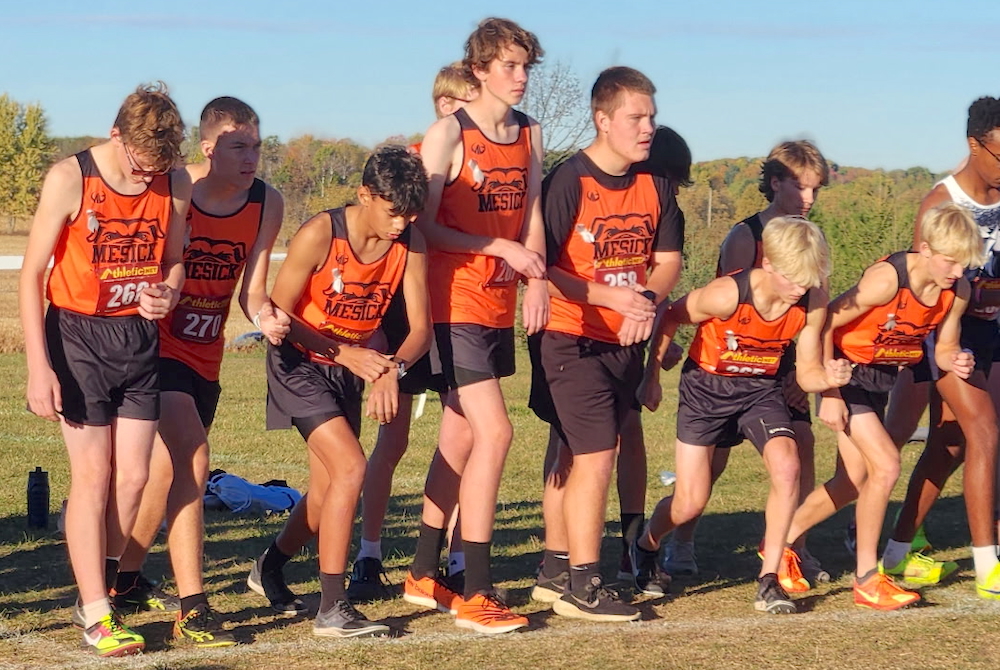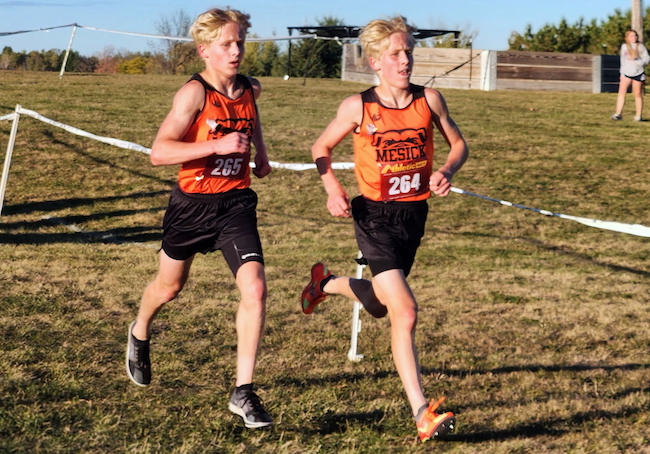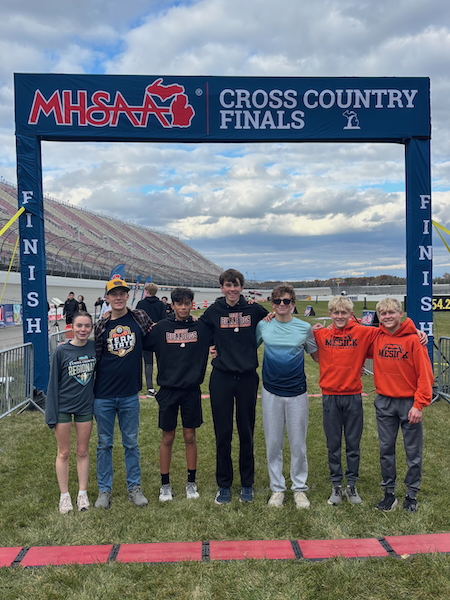
MHSAA Vault: MIS Rose to Challenges to Host 2020 LP Finals
By
Rob Kaminski
MHSAA benchmarks editor
November 12, 2021
The “MHSAA Vault” features stories from past publications and other documents in the MHSAA Library. This issue takes a look at the MHSAA Cross Country Finals at Michigan International Speedway, which celebrated 25 years in 2020 – although it was an event that nearly didn’t happen last fall …
In 1996, the MHSAA and Michigan International Speedway began a partnership the changed the course of the Lower Peninsula Cross Country Finals – quite literally.
The land in and around the track at Brooklyn would host the Finals for all classes of runners in one place on one day, an annual festival of nearly 2,000 runners competing for the MHSAA’s top honors.
Even skeptics – and there were several among running purists who thought the course was too flat, for example – can’t deny the results.
Finals attendance nearly doubled in that first year, and crowds in excess of 10,000 have enjoyed a day of racing several times, including a record 12,153 in 2011.
Enthusiastic crowds were the norm in recent years, with 11,232 in 2017, and nearly 11,000 in 2018 (10,989) and 2019 (10,873).
In fact, attendance failed to reach at least 8,000 only twice since the move to MIS.
Of course, last year was an exception, when attendance was limited to 1,000 spectators per session due to the COVID-19 Pandemic. Fans also were restricted to the grandstands rather than following the action throughout locations on the course.
To reduce the number of runners in each race, the event was spread over two days, with each Division being run in two separate “sections” with times then combined at the end to determine team and individual champions.
While not ideal, the end result was another year of fantastic efforts at MIS – both from student-athletes and those behind the scenes.
“Even at the last hour, less than a week ahead of the Finals, we were closer to not having the Finals than we were to having them,” said MHSAA Assistant Director Cody Inglis, who coordinates the cross country postseason. “Rumors and challenges of mandated shutdowns, testing and other requirements were being discussed and caused a lot of unknowns. Even at the Regional level, we had schools, Regional courses and hosts shutting down their facilities; we had to relocate four Regionals 48 hours prior to race times. That scenario just could not happen at the Finals level where far more runners and much more travel would be involved.”
Among the many last-minute hurdles was the edict from NASCAR – which owns MIS – that all persons on site be temperature checked upon entry. That meant securing thermometers that were easy to operate in short order, along with personnel necessary to conduct the readings.
The attendance limitations certainly helped to implement the temperature screening, but brought their own issues.
“Limiting spectators was not a popular decision, but it really was the only way to have a race,” Inglis said. “We were taking direction and working with policies and protocols from the MDHHS, the Governor’s office, Lenawee County Health Department, MIS and NASCAR.”
Part of the solution was to utilize the grandstands as a “barrier” between participants and spectators. The reduced number of fans were dispersed over thousands of seats while still allowing them the chance to watch their student-athletes compete.
“It wasn’t the same, it wasn’t easy or perfect, but it was what we had to do to have a race,” Inglis said. “Separating the Finals into two days and different sections also allowed us to spread out the event and limit the number of people on site at any one time. This was a key part of the plan and worked well even though it separated races within a Division.”
The MHSAA, MIS and the cross country community never lost focus of the main goal: a culmination of the season for the student-athletes, who deserved something last year more than ever. And, more than ever, MIS once again displayed its advantage as a venue that could adapt to the fluid nature of the times to pull off the event.
“There were some thoughts of using four different sites, but as we learned during the Regionals, the climate of things was so tenuous from one area of the state to another that we couldn’t be 100-percent certain that there wouldn’t again be last-minute cancelations,” Inglis said. “MIS was wonderful to work and collaborate with, and was the best option to get it done. It was never mentioned once publicly about the possibility of not having the Finals – only how we could best do it under uncharted conditions.”
The moving parts and ever-changing scenarios created more complexity than ever in finalizing a season, but every decision was made with the complete desire to conduct the Finals as close to normal as possible.
“I firmly believe that a finish to the season, no matter the differences in race formatting and fan experience, was something everyone would have taken when the season began in August,” Inglis said.
Indeed, the finish line in Year 25 at MIS might have been the most gratifying of them all.

After Season of Historic Finishes, Mesick Boys Looking Forward to Another Run
By
Tom Spencer
Special for MHSAA.com
November 22, 2025
Mesick just finished the best boys cross country season in school history.
 And the Bulldogs have even higher expectations for next year.
And the Bulldogs have even higher expectations for next year.
Mesick won a conference championship for the first time, and qualified for the MHSAA Lower Peninsula Division 4 Final for the first time in 38 years.
And the Bulldogs did it all without a senior in the lineup – meaning the entire lineup could be back for more in 2026.
“We’re coming back ready to stay fresh and just honestly do a lot more than we did this year,” said Kyle Redman, who ran a 15:40 to break his own school record and capture first place at his team’s Regional meet. “We want to keep building off that and dig deeper to go further.”
Redman was often the number one runner for Mesick, as was his twin brother Tyler, who finished just seven seconds behind him at the Regional.
Unfortunately, Tyler Redmond aggravated an ongoing hamstring injury and was unable to run in the Final.
“Every goal on our checklist, we hit,” said fourth-year Mesick coach Josh Kaskinen. “We won the conference. We qualified for states, and then right after that Regional race Ty found that he wasn't going to be able to go for states.”
 Mesick had entered just six runners in the Final, and called on Harper Musta to step up just as he did during the conference championship race.
Mesick had entered just six runners in the Final, and called on Harper Musta to step up just as he did during the conference championship race.
Musta, who was battling injuries too as he entered the Final, was the team’s number six runner all season. He ran as the fifth at Michigan International Speedway, ensuring Mesick could place as a team.
“I want to pat Harper on the back as I was a little nervous that we weren't going to score points at state even though we were ranked 11th coming in,” Kaskinen said. “Harper stepped up so that we could actually score and gave us all the experience that we need for next year.”
Despite missing a definite all-state candidate, Mesick still finished 21st at MIS, with Kyle Redman 11th.
The Bulldogs were not surprised Musta came through. He had done it earlier in the season, garnering a lot of credit for the school’s West Michigan D League title.
The Bulldogs narrowly came out on top of the conference championship race with 45 points. Mason County Eastern finished runner-up with 46, and Grand Traverse Academy wound up in third place with 47 points.
“Winning the conference was a big accomplishment,” Tyler Redman said. “For three or four years we were trying to just get people to run cross country, and everybody fought to actually get good at it.”
Kyle Redman led the way in the conference with a first-place finish. Tyler Redman was second. But it was first-year runner and sophomore Musta who found a way to figure in the scoring for the Bulldogs. He didn’t finish in the school’s top five but he did finish ahead of other schools’ top five runners.
“Harper is our assistant coach's older son, and he never ran before,” Kaskinen noted. “I told him leading into that championship meet that his job was to focus on Mason County Eastern's number five guy. I knew it was going to be a close race. And he was able to do it.”
Musta vividly recalls the race, passing Eastern’s fifth runner midway. He admits he wasn’t sure he was up to the challenge. The race gave him his first appreciation of the mental aspects of running.
 “It was a pretty interesting experience,” Musta said. “I actually had a goal in mind, and I had to keep on speeding up and pushing myself. And it was a lot more thinking than I'm usually used to.”
“It was a pretty interesting experience,” Musta said. “I actually had a goal in mind, and I had to keep on speeding up and pushing myself. And it was a lot more thinking than I'm usually used to.”
Musta expects to use that experience to help Mesick to even more success in the years ahead, as does freshman and number three runner Kyle Doty and the Bulldogs’ other regular scorers Gunnar Hallett and Alex Kastl.
With everyone returning, Kaskinen is already looking forward to next season.
“I do think it's going to be a little more competitive for that final scoring spot next year,” he said. “It's kind of cliche, but they were like a brotherhood. They really just came together, and they were closer than I've ever seen a group of kids before.”
Having identical twins lead the team and winning races has been pretty special for Mesick runners.
“It's definitely cool and interesting because we’ve been good friends for a while,” Hallett said. “They're kind of pushing me to do more. Sometimes we just get together and run. And then instantly it's a bit bigger group, and it's easier to do longer runs.”
The twins first started running in an elementary school club led by Rhonda Workman. They played football in middle school.
And while their teammates can tell the difference between the twins, opponents rarely can. All they often know is the guy finishing first was named Redman.
“We get to work off each other, and we have training partners throughout the whole season,” Kyle Redman said. “And it is fun when we’re warming up for the race and they'll be like, ‘Are you Kyle or Ty?’ And then you can just mess with them and they'll never actually know the truth.”
 Tom Spencer is a longtime MHSAA-registered basketball and soccer official, and former softball and baseball official, and he also has coached in the northern Lower Peninsula area. He previously has written for the Saginaw News, Bay County Sports Page and Midland Daily News. He can be reached at [email protected] with story ideas for Manistee, Wexford, Missaukee, Roscommon, Ogemaw, Iosco, Alcona, Oscoda, Crawford, Kalkaska, Grand Traverse, Benzie, Leelanau, Antrim, Otsego, Montmorency, Alpena, Presque Isle, Cheboygan, Charlevoix and Emmet counties.
Tom Spencer is a longtime MHSAA-registered basketball and soccer official, and former softball and baseball official, and he also has coached in the northern Lower Peninsula area. He previously has written for the Saginaw News, Bay County Sports Page and Midland Daily News. He can be reached at [email protected] with story ideas for Manistee, Wexford, Missaukee, Roscommon, Ogemaw, Iosco, Alcona, Oscoda, Crawford, Kalkaska, Grand Traverse, Benzie, Leelanau, Antrim, Otsego, Montmorency, Alpena, Presque Isle, Cheboygan, Charlevoix and Emmet counties.
PHOTOS (Top) Mesick runners line up for the start of the West Michigan D League championship race Oct. 15 at Marion. (Middle) Twins Kyle and Ty Redman lead the league finale. (Below) Mesick’s Finals qualifiers take a photo at the finish line at Michigan International Speedway. (Photos courtesy of the Mesick boys cross country program.)

